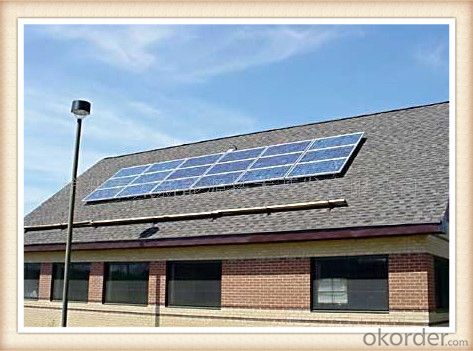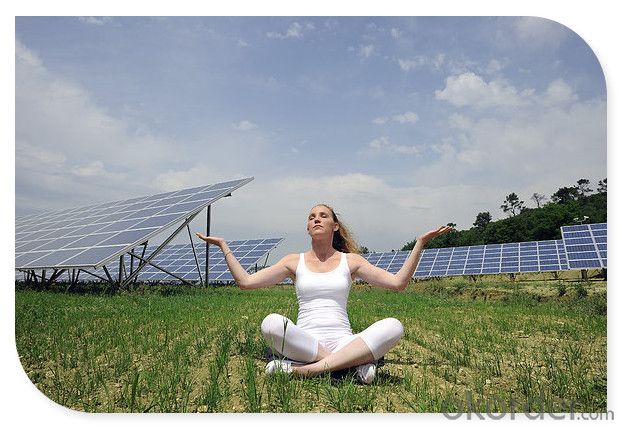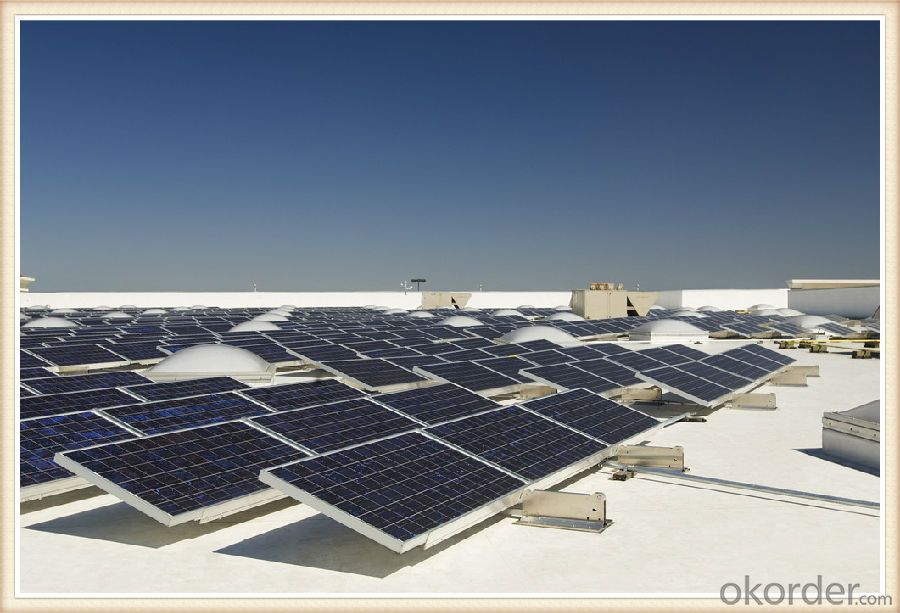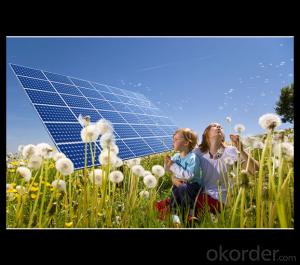240W Direct Factory Sale Price 240-255Watt Solar Panels
- Loading Port:
- China main port
- Payment Terms:
- TT OR LC
- Min Order Qty:
- 10000 watt
- Supply Capability:
- 100000 watt/month
OKorder Service Pledge
OKorder Financial Service
You Might Also Like
Item specifice



Solar Module Introduction
Solar modules use light energy (photons) from the sun to generate electricity through the photovoltaic effect. The majority of modules use wafer-based crystalline silicon cells or thin-film cells based on cadmium telluride or silicon. The structural (load carrying) member of a module can either be the top layer or the back layer. Cells must also be protected from mechanical damage and moisture. Most solar modules are rigid, but semi-flexible ones are available, based on thin-film cells. These early solar modules were first used in space in 1958.
Electrical connections are made in series to achieve a desired output voltage and/or in parallel to provide a desired current capability. The conducting wires that take the current off the modules may contain silver, copper or other non-magnetic conductive transition metals. The cells must be connected electrically to one another and to the rest of the system. Externally, popular terrestrial usage photovoltaic modules use MC3 (older) or MC4 connectors to facilitate easy weatherproof connections to the rest of the system.
Specification
Model Type | |
Peak Power-Pmax(W) | 5-200W |
Open Circuit Voltage-Voc(V) | 44.2 |
Maximum Power Voltage-Vmp(V) | 36 |
Short Circuit Current-Isc(A) | 5.4 |
Maximum Power Current-Imp(A) | 5 |
Maximum System Voltage | 1000V DC |
Maximum Series Fuse Rating | 10A |
Power Tolerance | -1~+3% |
Temperature Coefficients of Pmax | -0.45%/℃ |
Temperature Coefficients of Voc | -0.348%/℃ |
Temperature Coefficients of Isc | 0.031%/℃ |
Nominal Operating Cell Temperature | 44.5±2℃ |
Standard Testing Condition(STC) | Irradiance:1000W/m²;Temperature:25℃;AM=1.5 |
Qualification Test Parameters | |
Operating Temperature | -40℃~+85℃ |
Storage Temperature | -40℃~+85℃ |
Pressure Bearing | ≥5400Pascal/m² |
Wind Bearing | ≥5400Pascal/m² |
Mechanical Characteristics | |
Cell Size | Mono 125*125mm±0.5 |
No.of Cells | 72pcs(6*12) |
Dimension | 1580*808*40mm |
Weight | 15.5Kg |
Glass | 3.2mm High Transmission,Low Iron |
Frame | Anodized Aluminum Alloy |
Junction Box | IP65Rated |
Internal Diodes | 3 Bypass Diodes |
Cable | 1*4.0mm² Length 900mm |
Images
Packing & Shipping:
We have rich experience on how to pack the panels to make sure the safety on shipment when it arrives at the destination.
The normal size is packed by 25pcs/ carton / pallet. Paper carton for FCL shipping and wood carton for LCL shipping.
Features
1.High reliability with guaranteed -3% to +5% power output tolerance, ensuring return on investment
2.High conversion efficiency based on leading innovative photovoltaic technologies
3.Withstands high wind-pressure and snow load, and extreme temperature variations
4.Attractive appearanceUnique frame design, high mechanical strength, and easy Installation
Warranty:
For c-Si panel: 25years output warranty for no less than 80% of performance, 10 years output warranty for no less than 90% of performance. Free from material and workmanship defects within 5 years.
For a-Si panel: 20 years output warranty for no less than 80% of performance, 10 years output warranty for no less than 90% of performance. Free from material and workmanship defects within 2 years.
•100% product quality protection
•100% on-time shipment protection
•100% payment protection for your covered amount
FAQ:
(1)What price for each watt?
It depends on the quantity, delivery date and payment terms.
(2)What is your size for each module? Can you tell me the Parameter of your module?
We have different series of panels in different output, both c-Si and a-Si. Please take the specification sheet for your reference.
(3)Can you provide the peripheral products of the solar panels, such as the battery, controller, and inverter? If so, can you tell me how do they match each other?
Actually we are only manufacturer of solar panels, but we could try to source them for you in China if you need. We could provide you an optimal system design to instruct you how to install.
(4)Do you have the CE, TUV, UL Certification?
We’ve already passed all the tests, and any certificate is available.
(5)Have you ever sold your products to companies in my country?
Of course, we have customers in all general PV markets, but I think we should expand our market share along with the market growth.
(6)When did your company set up? You are a new company, how can I believe your quality?
We entered into Solar PV industry in 2005, now we have several plants in manufacturing of a-Si and c-Si panels, and our capacity is 220MW per year. Till now we have already passed all the tests by authorized laboratories, e.g. TUV, VDE, UL.
(7)Can you help us install the module if we cooperate with you?
We haven’t entered into installation sector, but we have the plan in near future.
(8) How do you pack your products?
We have rich experience on how to pack the panels to make sure the safety on shipment when it arrives at the destination.
(9) Can you do OEM for us?
Yes, we can.
(10)Can we visit your factory?
Surely, I will arrange the trip basing on your business schedule.
- Q:hi,i have 4 solar panels. I can get 9V 400mA when i wired them parallel. The question is: how can i make a regulator circuit to store power into batteries.
- wire them in series parallel to get 8 volts at 200 mA, and that should charge a 2 volt battery. You may want to put in a series diode to prevent the battery from discharging into the panel when the sun is out. At 200 mA, depending on the battery size, you may not need much control, as that low a current will not overcharge a large battery, like a small auto battery. In fact it will take a very long time to charge it. edit: But do i need to add a regulator? If by that you mean a voltage regulator, no, as a solar panel has a high output resistance, and that will limit the current into the battery. If you mean a charge controller, if the battery is small, you may need a charge contoller to avoid overcharging the battery. But that is not a voltage regulator. .
- Q:Can solar panels be installed on a factory or manufacturing plant?
- Yes, solar panels can be installed on a factory or manufacturing plant. In fact, many industrial facilities are increasingly adopting solar energy to meet their power needs and reduce their carbon footprint. The large roof areas and open spaces available in factories make them ideal locations for solar panel installations, enabling businesses to generate clean and renewable energy on-site while saving on electricity costs.
- Q:I have a cabin in the woods and need more light. I do have enough sun but I was wondering how or where do I get a solar panel to lead to a power outlet? In a perfect world I would like to get a solar panel with a connecting wire to an outlet or something so I could power a small TV. I know its hard enough but can I get that pre-made? Or even lastly should I look at wind power consider I would like this to be under $500? Thank you for putting up with this bundle of questions.
- Wow. I couldn't tell you how much something like that would cost, but I would expect it to be pretty high. I don't think you are going to find a panel out there that is going to pump out enough juice to provide 0ac. It would involve a battery system and a DC to AC power inverter. You would have to let the system charge for a time and then you would be able to use if for a little while.
- Q:How do you know when it is a good deal to buy a solar panel. For example, what is a good cost per watt, how many volts should I expect, etc.
- first okorder / example: house roof is 20' x 20' 20' = 240, so sq. inches of roof is = 57,600 say rain fall for your area is 3 per month on average. 57,600 x 3 = 72,800 of rain collected. Using the conversion chart link above, that many cubic inches of water = 750 gallons of water free per month. Look at your water bill and see how much you use. Solar panels take on average 2-20 yrs to pay themselves off, just in time for them to be replaced. Paddle wheels go on for just about forever. We still find large paddle wheel mills in the USA that are over 200 yrs old, and still functioning.
- Q:What is the impact of hailstorms on solar panels?
- Hailstorms can have a significant impact on solar panels. The impact of hailstones hitting the panels can cause physical damage, such as cracks or shattered glass, which can impair the panel's ability to generate electricity. This damage not only affects the efficiency of the solar panels but also necessitates costly repairs or replacements. Therefore, hailstorms pose a considerable risk to the overall performance and longevity of solar panels.
- Q:Are solar panels suitable for all types of roofs?
- Solar panels are suitable for most types of roofs, including flat, sloped, and curved roofs. However, the suitability of solar panels depends on factors like the roof's orientation, angle, shading, and structural integrity. It is essential to consult with a solar panel installer or a professional to determine the suitability of solar panels for a specific roof.
- Q:Can solar panels be installed in areas with high levels of saltwater exposure?
- Yes, solar panels can be installed in areas with high levels of saltwater exposure. However, it is important to choose solar panels that are specifically designed to withstand such conditions. These panels are typically made with corrosion-resistant materials and undergo rigorous testing to ensure durability in marine environments. Regular maintenance and cleaning may also be required to prevent salt buildup and optimize performance.
- Q:Hi, I am very interested in solar panels and would like to know more.Can someone please give me a basic explanation of how solar panels work?Thank you
- A solar panel is a panel of a certain material that is very sensitive to light. Now, when you place if out in the sunlight, the photons enter that material, and gets converted to energy in the form of electrostatic electrons. These electrons gets carried away by the small silver wires you see running zig-zag over the panel, and is then used as electronic current. It is actually a lot more intricate and detailed than this, but this is more or less how it works. The reason is works better in sunlight, is simply because sunlight has a lot more energy behind it than lightbulbs and other sources, but they work as well!
- Q:Can solar panels be used in disaster relief efforts?
- Yes, solar panels can be used in disaster relief efforts. They provide a sustainable and reliable source of electricity, which is crucial during emergencies when power grids may be down. Solar panels can be deployed quickly and easily, enabling the provision of essential services such as lighting, communication, and medical equipment in affected areas. Moreover, solar energy is renewable and environmentally friendly, reducing dependency on fossil fuels and minimizing the impact on already vulnerable communities.
- Q:Are there any government incentives or tax credits for installing solar panels?
- Yes, there are government incentives and tax credits available for installing solar panels. These incentives vary by country and state, but they often include federal tax credits, grants, rebates, and state-level incentives. These incentives aim to promote renewable energy adoption and can significantly reduce the cost of installing solar panels for residential and commercial properties. It is advisable to consult local government agencies or renewable energy organizations to get specific information about incentives available in your area.
1. Manufacturer Overview |
|
|---|---|
| Location | |
| Year Established | |
| Annual Output Value | |
| Main Markets | |
| Company Certifications | |
2. Manufacturer Certificates |
|
|---|---|
| a) Certification Name | |
| Range | |
| Reference | |
| Validity Period | |
3. Manufacturer Capability |
|
|---|---|
| a)Trade Capacity | |
| Nearest Port | |
| Export Percentage | |
| No.of Employees in Trade Department | |
| Language Spoken: | |
| b)Factory Information | |
| Factory Size: | |
| No. of Production Lines | |
| Contract Manufacturing | |
| Product Price Range | |
Send your message to us
240W Direct Factory Sale Price 240-255Watt Solar Panels
- Loading Port:
- China main port
- Payment Terms:
- TT OR LC
- Min Order Qty:
- 10000 watt
- Supply Capability:
- 100000 watt/month
OKorder Service Pledge
OKorder Financial Service
Similar products
New products
Hot products
Hot Searches
Related keywords






























